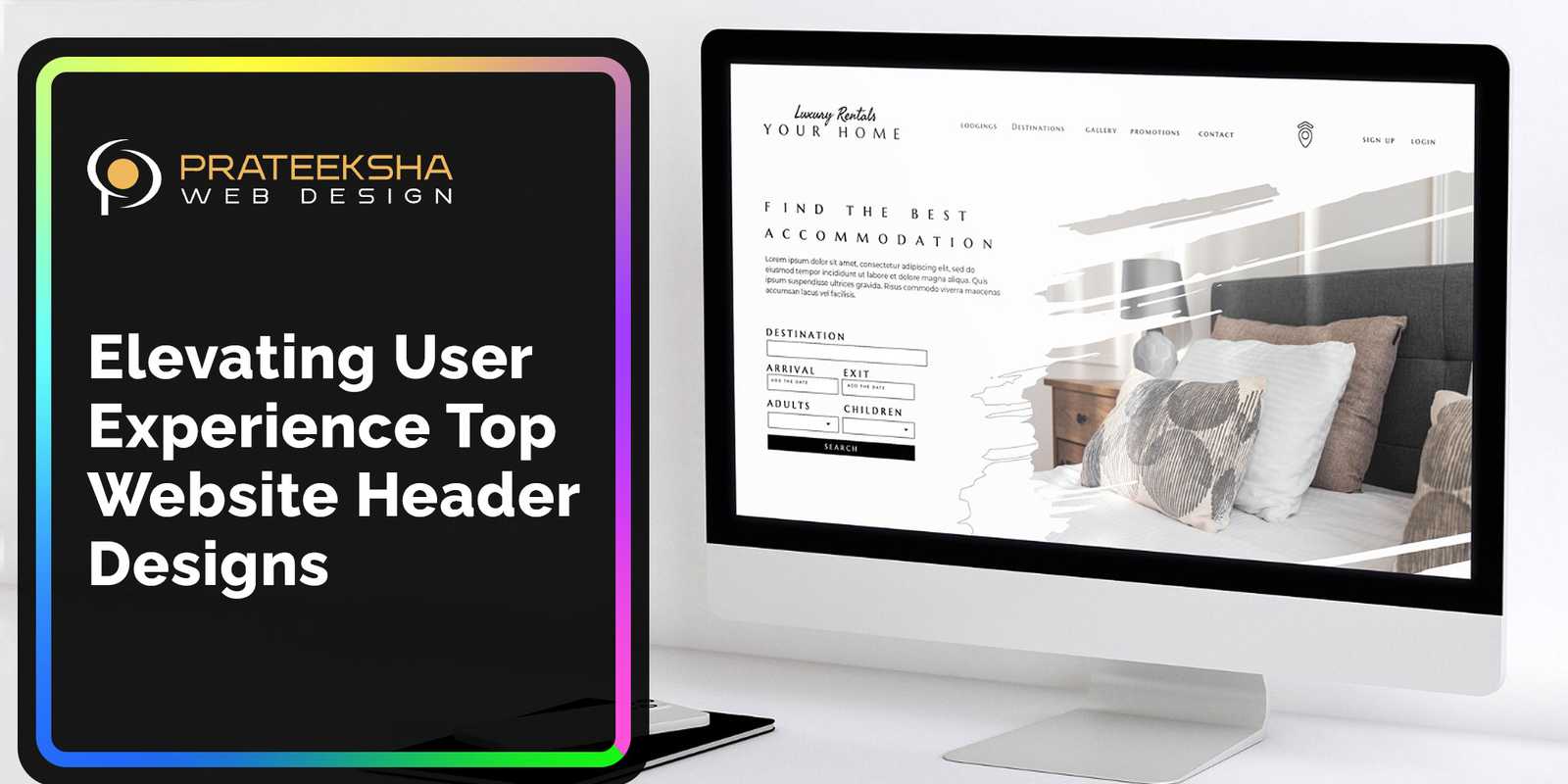What Is Website Header Design
Website header design refers to the creation and arrangement of elements at the topmost part of a website. This area is crucial as it's often the first thing visitors see and can significantly influence their first impression and overall experience on the site. The design of the website header plays a pivotal role in branding, navigation, and user engagement.
Definition and Importance of Website Header Design
Interaction
The website header is typically the first element that catches the eye of a visitor. This area, occupying the topmost part of the webpage, plays a pivotal role in framing the user's initial impression. It's not just a design element but a crucial part of the website's functionality and user experience. The header sets the tone for the entire site, subtly guiding the visitor's perception and expectations. In essence, it acts as the digital "front door" of a website, welcoming visitors and hinting at what lies beyond.
Branding Showcase
A key component of the website header is its role in showcasing the brand. This is typically where the company's logo and tagline are placed. By positioning these elements prominently, the header serves as a constant reminder of the brand identity throughout the user's journey on the site. This placement is strategic; it not only reinforces brand recognition but also creates a sense of familiarity and trust. The design, color scheme, and typography used in the header further contribute to the brand's narrative, conveying its values and personality.
Navigation Hub
The header also functions as the central navigation hub of a website. It typically houses the primary navigation menu, which includes links to the most important sections of the site. This menu is essential for good user experience, allowing visitors to easily find and access content. A well-organized and intuitive navigation structure in the header can significantly enhance the usability of a website, reducing frustration and helping users to efficiently find the information they need.
User Engagement
Well-designed website headers play a crucial role in user engagement. By providing clear and direct paths to important pages or actions, such as contact information, product pages, or sign-up forms, the header can influence the actions of the visitor. Features like call-to-action (CTA) buttons are often integrated into the header design to prompt specific user responses. The effectiveness of a header in engaging users can be a key determinant in the success of a website, impacting metrics like bounce rates, time on site, and conversion rates.
Design Considerations for Website Header Design
Aesthetic Harmony
The design of a website header must seamlessly integrate with the overall aesthetic of the site. This harmony is crucial for creating a cohesive and pleasant user experience. Key elements to consider include:
1. Color Scheme: The header should use colors that are consistent with the website's color palette. This consistency helps in reinforcing brand identity and ensures visual continuity.
2. Typography: The choice of fonts in the header should align with those used throughout the website. Consistent typography aids in readability and maintains a uniform look.
3. Graphic Style: Any graphical elements or imagery used in the header need to resonate with the style prevalent on the rest of the site. Whether it's minimalist, modern, or traditional, the style should be a continuous thread.
Responsiveness
With the diversity of devices used to access websites, responsiveness is a critical aspect of header design:
1. Adaptive to Screen Sizes: The header should adjust to different screen sizes, from large desktop monitors to smaller mobile screens.
2. Maintaining Functionality: As the header scales down for smaller devices, it should retain its functionality. This might involve repositioning elements or switching to a hamburger menu for mobile devices.
3. Visual Consistency: Despite changes in layout for different devices, the header should maintain visual consistency in terms of design elements.
User-Friendly Layout
The layout of the header is key in determining how easily users can navigate and use the website:
1. Intuitive Navigation: Users should be able to navigate through the website easily with the help of the header. The placement of menu items, search bars, and CTAs should be logical and intuitive.
2. Clutter-Free Design: Avoid overloading the header with too many elements. A clean and organized header is more user-friendly.
3. Clear Hierarchies: Visual hierarchies help in guiding the user's attention to the most important elements first, like the logo, navigation menu, or primary CTA.
Accessibility
1. Designing for accessibility ensures that the website is usable by everyone, including people with disabilities:
2. Screen Reader Compatibility: The header should be designed so that it is easily navigable with screen readers used by visually impaired users.
3. Keyboard Navigation: Ensure that all interactive elements in the header can be accessed and used with a keyboard.
Main Elements of Website Headers
Website headers, serving as the primary navigation and branding area, typically include several key elements. Each of these elements plays a vital role in enhancing the user experience, facilitating navigation, and reinforcing brand identity. Here are the main elements commonly found in website headers:
Logo:
The logo is a central element in the header, often placed in the top left or center. It's not just a branding tool; it also commonly serves as a clickable element that redirects users back to the homepage. This dual role makes the logo both a brand identifier and a practical navigational tool.
Navigation Menu:
The navigation menu is crucial for user experience. It includes links to the major sections of the website, such as "About Us", "Services", "Products", "Blog", and "Contact". The layout of the menu should be intuitive, making it easy for users to find what they're looking for.
Call-to-Action (CTA) Buttons:
CTAs are used to guide users towards desired actions, like "Sign Up", "Shop Now", or "Contact Us". These buttons are usually designed to stand out, often using contrasting colors or prominent placement to draw attention.
Search Function:
For websites with extensive content, a search bar is a critical element in the header. It allows users to quickly find specific information or products, enhancing the overall user experience.
Contact Information:
In some headers, especially for businesses, it's common to include essential contact information like a phone number or email address. This information is typically placed in a clearly visible spot for easy access.
Social Media Icons:
Links to social media profiles can be included in the header. These icons are usually subtle and placed in less prominent areas of the header, like the corners or alongside the contact information.
Shopping Cart Icon:
For e-commerce sites, a shopping cart icon is often included in the header. This icon usually shows a visual or numerical indication of how many items are in the user's cart and is a quick link to the checkout page.
Language Selection:
On websites serving international audiences, a language selection option is often included in the header. This feature allows users to switch the website's content to their preferred language.
User Account Access:
For websites with user accounts, access to login or account information is typically provided in the header. This may include links for logging in, registering, or accessing a personal account.
Promotional Banners:
Some websites use a small portion of the header to display promotional banners or important announcements. This can be an effective way to communicate timely information or special offers.
Types of Website Headers
Website headers, being a vital component of web design, come in various styles and formats. Each type serves different purposes and is chosen based on the website's overall design, functionality requirements, and user experience goals. Here are some of the common types of website headers:
Static Header:
This is the most basic type of header. It remains fixed and does not change or react as the user scrolls through the page. Static headers are straightforward, easy to design, and suit websites with a simple navigation structure.
Sticky Header:
A sticky (or fixed) header remains at the top of the screen even when the user scrolls down. This type is particularly useful for easy navigation, as it allows users to access the menu from anywhere on the page without having to scroll back to the top.
Dynamic or Animated Header:
These headers incorporate animations or dynamic effects that activate when the user interacts with them or when they scroll. Such headers can be visually engaging and add a modern feel to the website.
Hamburger Menu Header:
Often used in responsive or mobile designs, the hamburger menu is a three-line icon that expands to reveal the navigation menu when clicked. This type of header is great for saving space and maintaining a clean layout, especially on smaller screens.
Mega Menu Header:
Used by websites that have a wide range of categories or subcategories, such as large e-commerce sites or news websites. Mega menus display a large panel of navigation options, often with images and detailed lists, offering users a comprehensive view of the site's content at a glance.
Minimalist Header:
Emphasizing simplicity and space, minimalist headers typically feature only the most essential elements, like a logo and a simplified navigation menu. This type is popular among modern, design-focused websites.
Overlay Header:
This type of header overlaps with the website's main content, usually as a transparent or semi-transparent bar. It can give a modern and creative look to the website and is often paired with high-quality background images or videos.
Fullscreen Header:
Also known as a 'hero header', it typically takes up the entire screen and features high-impact visuals like full-screen images, slideshows, or videos with overlaid text and navigation elements. This type is effective for storytelling or creating a strong visual impact.
Centered Header:
The logo and navigation links are centered rather than aligned to the sides. This type is often used on websites that aim for a balanced, clean design.
Gridded Header:
Utilizes a grid-based layout for organizing navigation elements, logo, and additional features like search bars or CTAs. This type is favored for its structured and organized look.
Utility Header:
A small, secondary header placed above the main header. It typically contains secondary information or features like contact details, social media links, or language options.
5 Tips for Effective Website Header Design
Creating an effective website header is crucial since it's often the first thing visitors interact with. A well-designed header can significantly enhance the user experience, aid navigation, and strengthen brand identity. Here are five tips for designing an effective website header:
Prioritize Simplicity and Clarity:
-
Keep the header uncluttered and straightforward. Avoid overwhelming users with too much information or too many options.
-
Use clear, readable fonts and ensure that the color contrast between text and background is high for easy readability.
Ensure Consistent Branding:
-
The header should reflect your brand's identity consistently across all pages. This includes using your brand's logo, color scheme, and typography.
-
Consistent branding in the header reinforces brand recognition and provides a seamless experience for users.
Optimize for Navigation:
-
Structure the navigation menu intuitively. Group and label items logically so that users can find information quickly and easily.
-
Consider the most important pages or actions you want users to take and make these options prominent in the header.
Make it Responsive:
-
The header should adapt and look good on all devices, from desktop computers to smartphones.
-
On smaller screens, elements like the navigation menu might need to be condensed into a hamburger menu to save space and maintain usability.
Incorporate Accessibility:
-
Design your header with accessibility in mind to ensure that it's usable by everyone, including people with disabilities.
-
Use alt text for images, ensure keyboard navigability, and maintain a logical order of elements for screen reader users.
What Makes a Good Website Header Design?
A good website header design effectively combines aesthetics, functionality, and user experience principles to create a positive and memorable first impression for visitors.
Here are the key elements that contribute to a successful website header design:
Clear Brand Representation:
-
The header should prominently feature the brand's logo, ensuring it is immediately recognizable.
-
It should embody the brand's identity through consistent use of colors, fonts, and style, reinforcing brand recognition and trust.
Intuitive Navigation:
-
A well-designed header should offer clear and straightforward navigation, making it easy for users to find their way around the site.
-
Menus should be logically organized, with the most important links (such as Home, About Us, Services, Contact) being easily accessible.
Responsiveness and Mobile Compatibility:
-
The header must adapt seamlessly to different screen sizes and devices, maintaining functionality and design integrity on desktops, tablets, and smartphones.
-
Mobile considerations, such as a collapsible menu (hamburger menu), are essential for space optimization and user convenience on smaller screens.
User Engagement Features:
-
Effective headers often include call-to-action (CTA) buttons, such as "Contact Us", "Shop Now", or "Sign Up", designed to stand out and encourage user interaction.
-
These CTAs should be prominent but not overpowering, enticing users to take the next step in their journey on the site.
Minimalistic and Clutter-Free Design:
-
A clutter-free design helps in maintaining user focus and contributes to a better overall aesthetic.
-
The header should balance between including essential elements and keeping a clean, unobstructed layout.
Why is A Well-Designed Website Header Essential?
A well-designed website header is essential for several compelling reasons, all of which contribute to the overall effectiveness and success of a website. Here's why it holds such significance:
First Impression and Brand Image:
-
The header is typically the first thing a visitor sees, making it crucial for creating a positive first impression.
-
A well-designed header reflects professionalism and credibility, fostering trust in the brand.
Navigation and Usability:
-
The header plays a critical role in site navigation. A good design makes it easy for users to find what they're looking for, enhancing the overall user experience.
-
Clear, intuitive navigation in the header reduces frustration and helps prevent visitors from leaving the site prematurely.
Enhanced User Engagement:
-
Strategically placed call-to-action (CTA) buttons in the header can guide users towards important actions, like making a purchase, signing up, or getting in touch.
-
Engaging headers can encourage visitors to explore the site more thoroughly, increasing time spent on the site and the likelihood of conversion.
Consistent User Experience Across Devices:
-
A well-designed header ensures consistency in user experience across various devices, including desktops, tablets, and mobile phones.
-
Responsive header design adapts to different screen sizes, maintaining functionality and aesthetic appeal across platforms.
SEO and Performance:
-
Headers often include primary navigation and keywords, which can play a role in search engine optimization (SEO).
-
A well-optimized header contributes to faster page loading times, which is a factor in both user experience and search engine rankings.
5 Website Header Design Trends To Experiment With In 2024
As we move into 2024, website design continues to evolve, bringing new trends and styles to the forefront. Experimenting with these trends in website header design can give your website a fresh, modern look and enhance user engagement. Here are five website header design trends to consider for 2024:
Dynamic and Interactive Headers:
-
Moving beyond static designs, dynamic headers that change as the user scrolls or interacts with the page are becoming increasingly popular. This could include animations, interactive elements, or changes in color and content.
-
Such headers make the website more engaging and can provide a memorable experience for the user.
Minimalist and Clean Designs:
-
The trend of minimalism continues to be strong. Clean, uncluttered headers with plenty of white space help in focusing user attention on the most important elements.
-
This design approach is not only aesthetically pleasing but also improves site load times and readability.
Full-Screen Headers:
-
Full-screen headers, sometimes known as "hero images," make a bold statement. These headers typically feature high-quality, engaging images or videos that take up the entire screen, often with overlaid text or navigation elements.
-
This trend is particularly effective for storytelling, capturing attention, and creating an immediate visual impact.
Innovative Navigation Solutions:
-
As screens and devices diversify, there's a push towards innovative navigation solutions in headers. This includes hamburger menus on desktops, sticky navigation bars, or even experimental new layout patterns that challenge the traditional menu structure.
-
These innovative approaches can make navigation more intuitive and user-friendly, especially on devices with smaller screens.
Integrated Social Proof:
-
Integrating elements of social proof, like testimonials, user counts, or social media feeds, directly into the header is a trend gaining traction.
-
This approach can instantly boost credibility and engage users by showcasing community presence or user satisfaction right at the top of the page.




